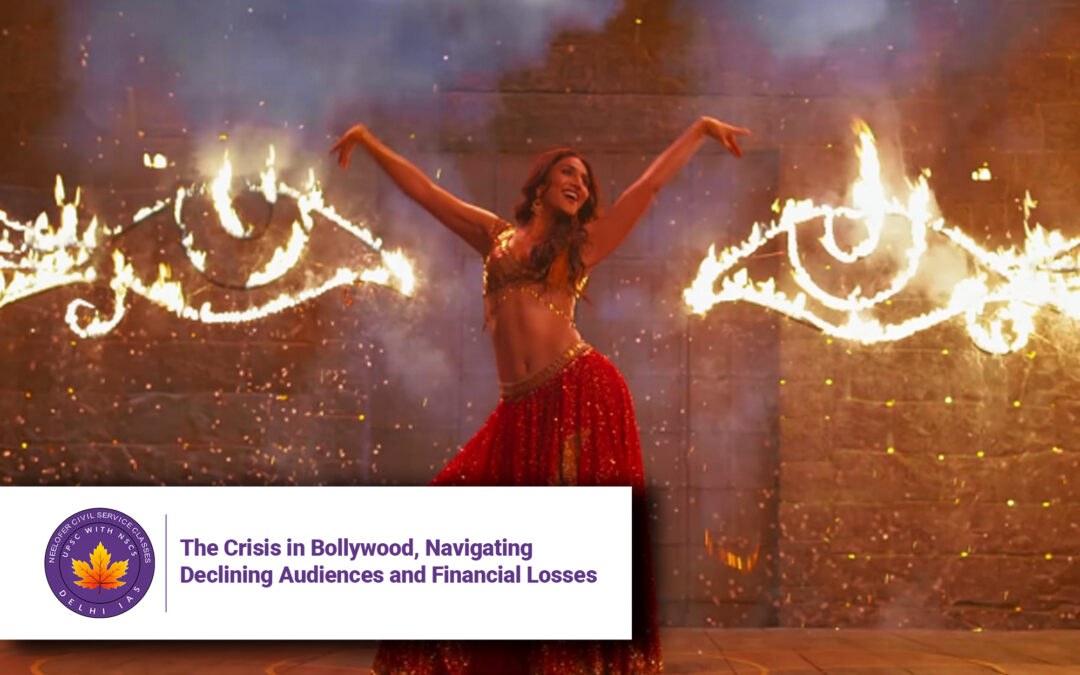The Crisis in Bollywood, Navigating Declining Audiences and Financial Losses
Why in News?
Bollywood, India’s iconic Hindi film industry, is facing an unprecedented crisis characterized by declining theater attendance, financial losses, and a erosion of its cultural mystique. The release of Alam Ara in 1931 marked the beginning of India’s sound film era, establishing cinema as a unifying force in the country’s diverse cultural landscape. However, over the past decade, a combination of social media toxicity, changing audience preferences, and economic challenges has led to a significant downturn in the industry’s fortunes. Trends like #BoycottBollywood, the rise of streaming platforms, and the COVID-19 pandemic have exacerbated these issues, forcing filmmakers to rethink their strategies. This article explores the multifaceted reasons behind Bollywood’s decline and potential pathways to revival.
Introduction
For decades, Bollywood has been more than just an entertainment industry; it has been a cultural phenomenon that shaped narratives, fostered national unity, and provided an escape for millions. However, the industry is now grappling with a perfect storm of challenges. Social media, once hailed as a tool for connectivity, has become a double-edged sword, amplifying negativity and misinformation. The allure of stardom has diminished as actors become overly accessible, and the economics of film production and exhibition have become increasingly unsustainable. Meanwhile, audiences are shifting their disposable income to alternative forms of entertainment, such as concerts, vacations, and digital content. This article delves into the factors contributing to Bollywood’s decline and examines how the industry can adapt to changing times.
Key Issues and Background
1. The Social Media Onslaught
Social media platforms like Facebook, Twitter, Instagram, and WhatsApp have transformed public discourse, but they have also become breeding grounds for toxicity. Hashtags like #BoycottBollywood trend regularly, often based on misinformation or targeted attacks. These campaigns create a narrative of antipathy toward the industry, discouraging audiences from watching films in theaters. The encrypted nature of platforms like WhatsApp allows misinformation to spread rapidly, further damaging Bollywood’s reputation.
2. Loss of Mystique and Stardom
In the past, Bollywood stars were enigmatic figures, revered from a distance. The advent of social media and paparazzi culture has demystified celebrities, showcasing their mundane daily lives and reducing their larger-than-life appeal. Actors’ descent into the social media fray, often engaging in fan wars or promoting sponsored content, has eroded the magic that once defined stardom. This overexposure makes it difficult for audiences to see them as aspirational figures.
3. Economic Challenges
The economics of filmmaking have become increasingly untenable:
-
Skyrocketing Costs: Production costs have risen by 20% over the past five years, but fees for stars and directors have increased by 200% to 500%. This inflation makes it difficult for films to achieve profitability.
-
Exhibition Struggles: Theater chains like PVR-Inox are facing significant losses due to high real estate costs and competition from streaming platforms. To compensate, theaters rely on advertisements and snack sales, which often disrupt the cinematic experience.
-
Revenue Streams: Streaming platforms offer an alternative revenue source, but they also compete with theaters for audience attention. The pandemic accelerated this shift, with many viewers preferring the convenience of home entertainment.
4. Changing Audience Preferences
Modern audiences have more choices for how they spend their time and money. Concerts, vacations, and other experiential activities are increasingly preferred over cinema visits. Additionally, the quality of content expected by audiences has risen, with viewers demanding fresh narratives and high production values. Bollywood’s reliance on formulaic plots and star power is no longer sufficient to attract crowds.
5. Structural Issues in the Industry
Bollywood faces internal challenges, including:
-
Nepotism: The industry’s reliance on star families has led to accusations of exclusivity and a lack of opportunities for outsiders.
-
Creative Stagnation: Many films fail to innovate, relying on tired tropes and predictable storylines.
-
Piracy: Illegal streaming and downloads further reduce revenue for filmmakers.
Specific Impacts or Effects
1. Box Office Performance
Many big-budget Bollywood films have underperformed at the box office in recent years. Even movies featuring A-list stars have failed to attract audiences, leading to significant financial losses for producers and investors.
2. Theater Closures
The decline in footfall has forced many single-screen theaters to shut down, particularly in smaller towns and rural areas. Multiplexes are also struggling, with some reducing screen counts or diversifying into other entertainment offerings.
3. Mental Health of Industry Professionals
The constant scrutiny and negativity on social media have taken a toll on the mental health of actors, directors, and producers. Many have spoken out about the pressure and toxicity they face.
4. Shift to Digital Platforms
While streaming platforms offer a lifeline for content creators, they also contribute to the decline of theatrical revenue. Films released directly on digital platforms often fail to generate the same level of cultural impact as theatrical releases.
Challenges and the Way Forward
Challenges
-
Rebuilding Trust: Overcoming the negativity fueled by social media campaigns.
-
Economic Sustainability: Reducing production costs and finding new revenue models.
-
Innovation in Content: Creating fresh, engaging stories that resonate with modern audiences.
-
Competition from Alternatives: Convincing audiences to choose cinema over other forms of entertainment.
Steps Forward
-
Embrace Digital Transformation: Leverage social media for positive engagement rather than allowing it to be a source of toxicity. Use data analytics to understand audience preferences.
-
Reduce Dependency on Stars: Focus on content-driven films rather than star-powered projects. This can help control costs and attract audiences based on storytelling rather than celebrity.
-
Enhance Theater Experiences: Improve the quality of theater visits by reducing distractions like excessive advertisements and interruptions. Offer immersive experiences, such as IMAX or 4DX, to differentiate from home viewing.
-
Diversify Revenue Streams: Explore hybrid release models, where films are released in theaters and on streaming platforms after a window period. This can maximize reach and revenue.
-
Promote Inclusivity: Address issues like nepotism by fostering new talent and encouraging diverse voices in storytelling.
-
Combat Piracy: Work with authorities to crack down on illegal streaming sites and protect intellectual property.
Conclusion
Bollywood’s current crisis is a reflection of broader societal and economic shifts. However, the industry has a history of resilience and reinvention. By addressing its structural issues, embracing innovation, and reconnecting with audiences, Bollywood can navigate this challenging period. The key lies in balancing commercial interests with artistic integrity and adapting to the evolving preferences of viewers. As filmmaker Anubhav Sinha aptly notes, filmmakers are obsessive people who will continue to create despite the odds. The audience, too, remains eager for compelling stories. The future of Bollywood depends on its ability to evolve while staying true to its essence.
5 Questions and Answers
Q1: What are the main reasons for Bollywood’s decline?
A: Key reasons include social media toxicity, loss of star mystique, rising production costs, competition from streaming platforms, and changing audience preferences.
Q2: How has social media impacted Bollywood?
A: Social media has amplified negative campaigns like #BoycottBollywood, reduced the mystique of stars, and created a toxic environment that discourages audience engagement.
Q3: What economic challenges does Bollywood face?
A: The industry struggles with skyrocketing production costs, high fees for stars and directors, theater losses, and competition from alternative entertainment options.
Q4: How can Bollywood revive its fortunes?
A: By focusing on content-driven films, reducing dependency on stars, improving theater experiences, diversifying revenue streams, and embracing digital transformation.
Q5: What role do streaming platforms play in Bollywood’s crisis?
A: Streaming platforms offer alternative revenue but also compete with theaters for audience attention, reducing box office earnings and cultural impact.



